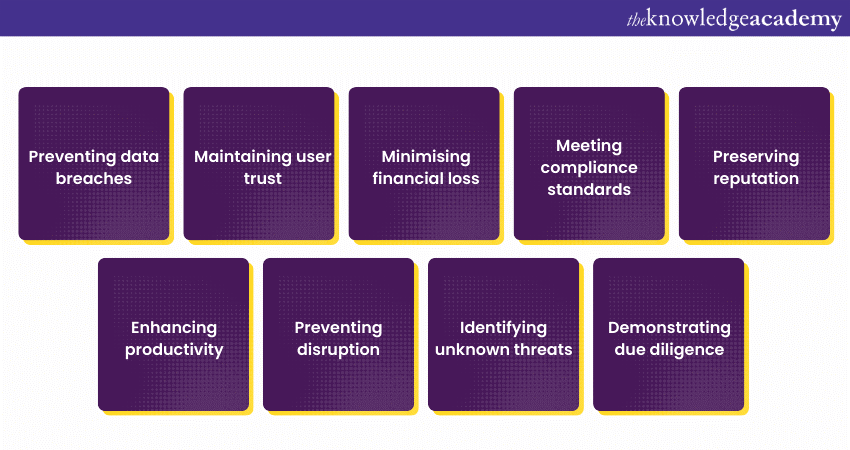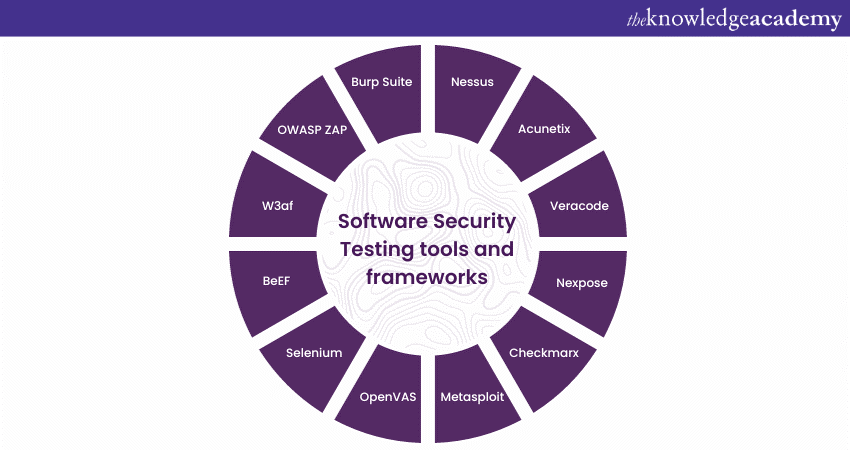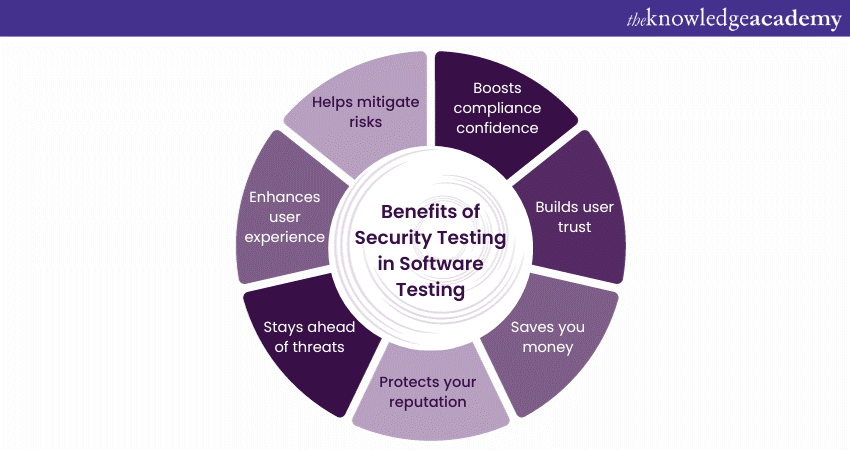We may not have the course you’re looking for. If you enquire or give us a call on 01344203999 and speak to our training experts, we may still be able to help with your training requirements.
Training Outcomes Within Your Budget!
We ensure quality, budget-alignment, and timely delivery by our expert instructors.

With the fast-evolving landscape of technology and digitalisation, ensuring the security of software applications has become a paramount concern. The rising complexity of software systems, coupled with the constant threat of breaches and cyberattacks, highlights the critical need for robust security measures. This is where Security Testing in Software Testing steps in as an essential practice to safeguard applications from potential vulnerabilities and threats.
According to Glassdoor, the average gross salary of a Penetration Tester in the UK is about £56,360 annually. If you are interested in pursuing a career in this role, then you should be familiar with the concepts of Security Testing, and that is what this blog is all about. In this blog, you will learn about Security Testing in Software Testing, its importance, different types, benefits and best practices. Let's dive in to learn more!
Table of Contents
1) What is Security Testing in Software Testing?
2) Importance of Security Testing in Software Testing
3) Types of Security Testing in Software Testing
4) Software Security Testing tools and frameworks
5) Exploring Security Testing in Software Testing with examples
6) Best practices for Software Security Testing
7) Benefits of implementing Security Testing in Software Testing
8) Conclusion
What is Security Testing in Software Testing?
Security Testing in Software Testing refers to the systematic process of evaluating a software application's ability to withstand potential security threats and vulnerabilities. It involves identifying weaknesses, flaws, and loopholes that malicious individuals could exploit to compromise the following:
1) Confidentiality
2) Integrity
3) Availability
The main objective of Software Testing is to make sure that the software's protective measures are robust enough to thwart unauthorised access, data breaches, and other security breaches.
Importance of Security Testing in Software Testing
The significance of Security Testing in Software Testing is significant. It serves as a critical safeguard against the growing landscape of cyber threats and vulnerabilities. It helps by identifying and rectifying security weaknesses early in the Software Development Lifecycle (SDLC). Let’s explore more on Software Security Testing’s importance:

1) Preventing data breaches: Testing Software Security helps uncover vulnerabilities that could possibly lead to data breaches. It helps protect sensitive user information from getting into the wrong hands.
2) Maintaining user trust: Users expect software to be secure. Through rigorous Testing of Software Security, Software Developers can build and maintain user trust by assuring them that their data is safe.
3) Minimising financial loss: A security breach can result in significant financial losses due to legal penalties, regulatory fines, and potential lawsuits. Effective Security Testing reduces the risk of such financial setbacks.
4) Meeting compliance standards: Many industries have specific security guidelines and compliance standards that must be met. Testing Software Security ensures that software aligns with these requirements, avoiding legal complications.
5) Preserving reputation: Security breaches can tarnish a company's reputation and may lead to a loss of business. Robust Testing helps avoid such reputational damage by ensuring the software's integrity.
6) Enhancing productivity: Once the software has been deployed, fixing security vulnerabilities can be time-consuming and costly. Early detection through Testing streamlines the development process and saves resources.
7) Preventing disruption: A successful cyber-attack can disrupt software functionality, causing downtime and inconvenience for users. Testing Software Security helps prevent such disruptions.
8) Identifying unknown threats: As new attack vectors and techniques emerge, Testing helps identify previously unknown threats. This allows Developers to stay ahead of potential vulnerabilities.
9) Demonstrating due diligence: Security-conscious organisations can demonstrate their commitment to safeguarding user data and adhering to best practices by Testing Software Security.
Elevate your career with our Certified Software Testing Professional (CSTP) Course - sign up now!
Types of Security Testing in Software Testing
Security Testing in Software Testing involves various methodologies to ensure robust protection against potential vulnerabilities and threats. Here are some of its key types:
1) Vulnerability Assessment: It means identifying weaknesses within the software's architecture that malicious actors could exploit. This Assessment helps prioritise areas needing attention.
2) Penetration Testing: It involves simulating real-world attacks to evaluate the system's response and defence mechanisms. Ethical hackers attempt to breach the software to address vulnerabilities.
3) Security Auditing: Security Auditing means reviewing the software's code and configurations to ensure compliance with security standards. This proactive measure identifies vulnerabilities early.
4) Risk Assessment: It involves identifying potential risks by analysing the software's assets, threats, and vulnerabilities. This Assessment prioritises security measures.
5) Security Scanning: This means using automated tools to scan the software for known vulnerabilities. This method identifies common security issues quickly.
6) Authentication and Authorisation Testing: This type of Testing involves evaluating the software's verification and authorisation techniques to ensure only authorised users access specific functionalities and data.
7) Encryption Testing: This means assessing encryption methods used to protect data during transmission and storage. This Testing ensures sensitive information remains confidential.
Software Security Testing tools and frameworks
In the realm of Software Security Testing, numerous specialised tools and frameworks are available to assist Developers in identifying vulnerabilities and strengthening their applications. Here are some notable options:

1) OWASP ZAP: An open-source tool for finding security vulnerabilities in web applications. It offers automated scanners, intercepting proxy, and various other features for thorough Testing.
2) Burp Suite: A comprehensive platform for Web Application Security Testing. It includes a variety of tools, such as a scanner, proxy, and crawler, to identify and address security issues.
3) Nessus: A widely used vulnerability scanner that helps identify weaknesses in networks, systems, and applications. It offers a vast database of vulnerabilities for accurate Testing.
4) Acunetix: A web vulnerability scanner designed to detect and manage a wide range of security issues in web applications. It offers a user-friendly interface and automation features.
5) Veracode: A cloud-based application security platform that provides dynamic and static analysis, as well as Manual Penetration Testing capabilities.
6) Nexpose: A vulnerability management tool that assists in discovering, assessing, and remediating security risks across various assets in the network.
7) Checkmarx: Checkmarx is a popular Static Application Security Testing (SAST) tool that identifies vulnerabilities in the source code of applications during development.
8) Metasploit: An open-source Penetration Testing framework that aids in identifying vulnerabilities, verifying their exploitability, and managing security assessments.
9) OpenVAS: An open-source Vulnerability Assessment scanner that helps detect vulnerabilities and misconfigurations in networks and systems.
10) Selenium: Primarily used for Functional Testing, Selenium can also be extended to perform Security Testing by automating tasks and simulating attacks.
11) BeEF: An open-source Penetration Testing tool that focuses on exploiting vulnerabilities present within web browsers.
12) W3af: W3af is a popular framework for web application attack and auditing and helps identify security weaknesses and vulnerabilities.
Master the art of Software Testing leadership with our Certified Software Testing Manager (CSTM) Training - sign up today!
Exploring Security Testing in Software Testing with examples
Security Testing in Software Testing is a vital process to ensure the robustness and integrity of software applications against potential threats. Let's delve into some examples to understand how Testing Software’s Security works:
1) SQL Injection Testing: Assessing the system's resistance to SQL injection attacks by attempting to manipulate database queries through input fields.
2) Cross-site Scripting (XSS) Testing: Identifying potential vulnerabilities that could allow hackers to insert malicious scripts into the website, compromising user data.
3) Authentication Bypass Testing: Evaluating the effectiveness of authentication mechanisms by attempting unauthorised access to user accounts.
4) Privacy Testing: Ensuring that user profiles and personal information are not accessible to unauthorised users.
5) Data Encryption Testing: Verifying that sensitive data, such as account numbers and passwords, is properly encrypted during transmission and storage.
By identifying vulnerabilities and addressing them proactively, Software Developers can create applications that are resilient against cyber threats and provide a secure user experience. Testing Software Security is an ongoing process that evolves as new threats emerge. It ensures that software remains robust and trustworthy in an ever-changing digital landscape.
Best practices for Software Security Testing
When it comes to Testing Software Security, following industry best practices is crucial to ensure comprehensive protection against potential vulnerabilities and threats. Here are some key best practices to consider:
1) Incorporate security from the beginning: Begin by integrating safety measures into the SDLC right from the design phase. This proactive approach prevents security issues from cropping up later in the development process.
2) Regular updates and patches: Keep your software updated with the latest security patches. Regularly addressing known vulnerabilities reduces the risk of exploitation by malicious actors.
3) Utilise encryption: Implement encryption to safeguard sensitive data during transmission and storage. This added layer of protection ensures that even if attackers gain access, the data remains indecipherable.
4) Implement strong access controls: Establish robust access control mechanisms that restrict users' permissions based on their roles. This prevents unauthorised users from accessing critical functionalities or sensitive data.
5) Thorough input validation: Ensure all user inputs are thoroughly validated and sanitised. This practice prevents common injection attacks like SQL Injection or Cross-site Scripting that exploit poor input handling.
6) Provide ongoing security training: Offer continuous security training to Developers. Also, keep them informed about the latest threats, attack techniques, and best practices.
7) Perform code reviews with a security focus: Conduct regular code reviews with a specific focus on identifying and addressing security vulnerabilities. This practice ensures that security is an integral part of the overall code quality assessment.
8) Leverage automated Security Testing: Make use of Automated Testing tools to efficiently scan code and identify potential vulnerabilities. These tools streamline the process and catch issues that might be missed through manual review.
9) Focus on secure configuration management: Properly configure servers, databases, and other components to adhere to established security standards. This minimises potential attack surfaces and vulnerabilities.
10) Implement application whitelisting: Employ application whitelisting to ensure that only approved and trusted applications can run on your system. This prevents unauthorised and potentially malicious software from executing.
By adhering to these best practices, you create a strong foundation for Software Security Testing, ensuring that your applications are robust, resilient, and capable of withstanding evolving cyber threats. Incorporating these practices throughout the SLDC enhances not only the security of your software but also the overall quality and user experience.
Supercharge your Automation Testing skills with our Software Testing And Automation Training - sign up now!
Benefits of Implementing Security Testing in Software Testing
Implementing Security Testing in Software Testing Techniques offers a multitude of advantages that contribute to the overall integrity, reliability, and trustworthiness of software applications. So, let's explore its key benefits:

1) Getting ahead of vulnerabilities early on saves you from potential data breaches and financial losses down the line.
2) Following industry standards ensures that you're on the right side of regulations, keeping legal troubles at bay.
3) Your users feel safer when they know their information is in good hands. Thus, Testing Software Security builds that crucial trust.
4) Fixing security issues in the development phase is much cheaper than dealing with them after launch.
5) Security breaches can tarnish your brand. However, having a strong defence protects your reputation and user loyalty.
6) With cyber threats evolving, regular Testing keeps your software resilient against new dangers.
7) When users feel safe and secure, their experience with your software becomes more positive and enjoyable.
By integrating Testing Software Security into the SLDC, Developers ensure that their Software applications are fortified against ever-evolving cyber threats. These benefits collectively contribute to a safer digital landscape, enhanced user experiences, and the success of Software products in the market.
Conclusion
We hope that after reading this blog, you have understood everything about Security Testing in Software Testing. In a technology-driven world, Security Testing is paramount. It safeguards applications, builds user trust, and thwarts cyber threats. By integrating robust security practices, Developers ensure software integrity, fostering a safer digital landscape for all.
Elevate your Software expertise with our cutting-edge Software Testing Courses – sign up now!
Frequently Asked Questions
Upcoming Business Analysis Resources Batches & Dates
Date
 ISTQB Software Testing Foundation
ISTQB Software Testing Foundation
Mon 6th Jan 2025
Mon 3rd Feb 2025
Mon 17th Feb 2025
Mon 3rd Mar 2025
Mon 17th Mar 2025
Mon 31st Mar 2025
Mon 28th Apr 2025
Mon 19th May 2025
Mon 2nd Jun 2025
Mon 16th Jun 2025
Mon 30th Jun 2025
Mon 14th Jul 2025
Mon 28th Jul 2025
Mon 11th Aug 2025
Mon 8th Sep 2025
Mon 22nd Sep 2025
Mon 6th Oct 2025
Mon 20th Oct 2025
Mon 3rd Nov 2025
Mon 17th Nov 2025
Mon 1st Dec 2025
Mon 15th Dec 2025







 Top Rated Course
Top Rated Course



 If you wish to make any changes to your course, please
If you wish to make any changes to your course, please


